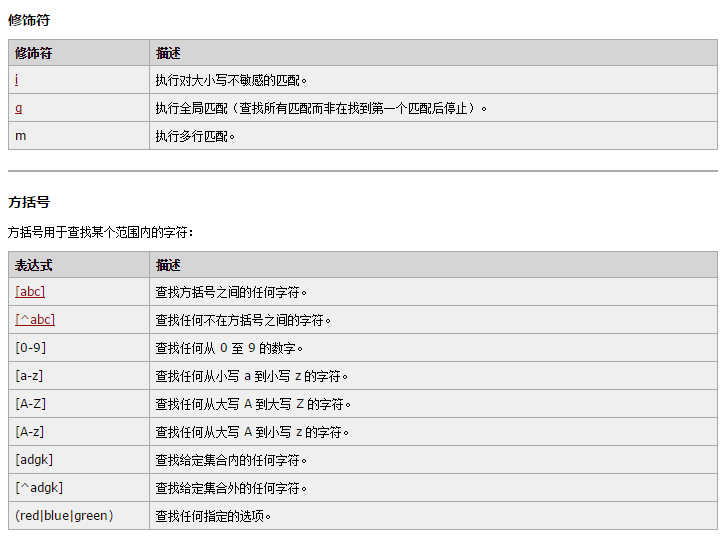行的开头(^)
^匹配每一行的开头
[root@sishen ~]# sed -n '/^103/ p ' employee.txt
103,Raj Reddy,Sysadmin
只有^出现在正则表达式开头时,它才匹配行的开头,所以,^N匹配所有以N开头的行。
行的结尾($)
$匹配行的结尾
显示以字符r结尾的行
[root@sishen ~]# sed -n '/r$/ p' employee.txt
102,Jason Smith,IT Manager
104,Anand Ram,Developer
105,Jane Miller,Sales Manager
单个字符(.)
元字符点 . 匹配除换行符之外的任意单个字符
l . 匹配单个字符
l . . 匹配两个字符
l . . .匹配三个字符
l …..依次类推
下面的例子中,模式”J后面跟三个字符和一个空格”将被替换为“Jason后面一个空格”
所以“J····“后面同时匹配employee.txt文件中的“John”和“Jane”,替换结果如下
[root@sishen ~]# sed -n 's/J.../Jason/ p' employee.txt
101,Jason Doe,CEO
102,Jasonn Smith,IT Manager
105,Jason Miller,Sales Manager
匹配0次或多次(*)
星号*匹配0个或多个其前面的字符,如:1*匹配0个或多个1
首先建立测试文件
[root@sishen ~]# vim log.txt
log:input.txt
log:
log:testing resumed
log:
log:output created
例如:只查看包含log且后面有信息的行
[root@sishen ~]# sed -n '/log: *./p' log.txt #注意log冒号后面有空格,而且点也是必须的
log:input.txt
log:testing resumed
log:output created
匹配一次或多次(\+)
“\+”匹配一次或多次他前面的字符,例如 空格\+ 或 “\+“匹配至少一个或多个空格
只显示包含log且log后面有一个或多个空格的所有行
[root@sishen ~]# sed -n '/log: \+/ p' log.txt
log: input.txt
log: testing resumed
注意<tab>与空格不同
零次或一次匹配(\?)
\?匹配0次货一次他前面的字符
[root@sishen ~]# sed -n '/log: \?/ p' log.txt
log: input.txt
log:
log: testing resumed
log:
log:output created
转义字符(\)
如果要在正则表达式中搜寻特殊字符(如:*, .)必须使用\来转义它们
[root@sishen ~]# sed -n '/127\.0\.0\.1/ p' /etc/hosts
127.0.0.1 localhost localhost.localdomain localhost4 localhost4.localdomain4
字符集[0-9]
匹配包含2、3、或者4的行
[root@sishen ~]# sed -n '/[234]/p' employee.txt
102,Jason Smith,IT Manager
103,Raj Reddy,Sysadmin
104,Anand Ram,Developer
注意:方括号中,可以是哟个连接字符指定一个字符范围,如[0123456789]可以用[0-9]表示,字母可以用[a-z],[A-Z]表示,等等
匹配包含2、3或者4的行另一种方式
[root@sishen ~]# sed -n '/[2-4]/p' employee.txt
102,Jason Smith,IT Manager
103,Raj Reddy,Sysadmin
104,Anand Ram,Developer
其他正则表达式
或操作符(|)
管道符号用来匹配两边任意一个子表达式,子表达式1|子表达式2匹配子表达式1或者子表达式2
打印包含101或者包含102的行
[root@sishen ~]# sed -n '/101\|102/p' employee.txt
101,John Doe,CEO
102,Jason Smith,IT Manager
打印包含数字2~3或者包含105的行
[root@sishen ~]# sed -n '/[2-3]\|105/p' employee.txt
102,Jason Smith,IT Manager
103,Raj Reddy,Sysadmin
105,Jane Miller,Sales Manager
精确匹配m次({m})
正则表达式后面跟上{m}注明精确匹配该正则m次
首先建立测试文件
[root@sishen ~]# vim number.txt
1
12
123
1234
12345
123456
打印包含任意数字的行(相当于打印所有的行对于该文件来说)
[root@sishen ~]# sed -n '/[0-9]/p' number.txt
1
12
123
1234
12345
123456
打印只包含5个数字的行
[root@sishen ~]# sed -n '/^[0-9]\{5\}$/p' number.txt
12345
注意这里一定要有开头和结尾符号
匹配m至n次({m,n})
正则表达式后面跟上{m,n}表明精确匹配该正则至少m,最多n次,m和n不能是负数,并且要小于255
打印由3至5个数字组成的行
[root@sishen ~]# sed -n '/^[0-9]\{3,5\}$/ p' number.txt
123
1234
12345
正则表达式后面跟上{m,}表明精确匹配该正则至少m,最多不限,(同样如果是{,n}表明最多n次最少一次)
字符边界(\b)
\b用来匹配单词开头(\bxx)或(xx\b)的任意字符,因此\bthe\b将匹配the,但不匹配they,\bthe将匹配the或they
首先建立测试文件
[root@sishen ~]# vim words.txt
word matching using:the
word matching using:thethe
word matching using:they
匹配包含the作为整个单词的行
[root@sishen ~]# sed -n '/\bthe\b/ p' words.txt
word matching using:the
注意如果没有后面的那个\b,效果将等同匹配包含所有以the开头的单词的行
[root@sishen ~]# sed -n '/\bthe/ p' words.txt
word matching using:the
word matching using:thethe
word matching using:they
回溯引用(\n)
使用回溯引用可以给正则表达式分组,以便后面引用他们
只匹配重复the两次的行
[root@sishen ~]# sed -n '/\(the\)\1/ p' words.txt
word matching using:thethe
同理,“\([0-9]\)\1“匹配连续两个相同的数字,如11,22,33 ····
在sed替换中使用正则表达式
把employee.txt 中每行最后两个字符替换为“Not defined “:
[root@sishen ~]# sed -n 's/..$/,Not Defined/ p' employee.txt
101,John Doe,C,Not Defined
102,Jason Smith,IT Manag,Not Defined
103,Raj Reddy,Sysadm,Not Defined
104,Anand Ram,Develop,Not Defined
105,Jane Miller,Sales Manag,Not Defined
删除Manager及其以后的字符:
[root@sishen ~]# sed 's/Manager.*//' employee.txt | cat -A
101,John Doe,CEO$
102,Jason Smith,IT $
103,Raj Reddy,Sysadmin$
104,Anand Ram,Developer$
105,Jane Miller,Sales $
注意:原文中没有“|cat -A“,是为了表现102和105最后的空格而添加的
删除所有以#开头的行
[root@sishen ~]# cat employee.txt
101,John Doe,CEO
102,Jason Smith,IT Manager
103,Raj Reddy,Sysadmin
104,Anand Ram,Developer
105,Jane Miller,Sales Manager
#106,Jane Miller,Sales Manager
#107,Jane Miller,Sales Manager
[root@sishen ~]# sed -e 's/^#.*// ; /^$/d' employee.txt
101,John Doe,CEO
102,Jason Smith,IT Manager
103,Raj Reddy,Sysadmin
104,Anand Ram,Developer
105,Jane Miller,Sales Manager
[root@sishen ~]# sed '/^#/d' employee.txt
101,John Doe,CEO
102,Jason Smith,IT Manager
103,Raj Reddy,Sysadmin
104,Anand Ram,Developer
105,Jane Miller,Sales Manager
首先建立test.html文件
[root@sishen ~]# vim test.html
<html><body><h1>Hello word!</h1></body></html>
清楚test.html文件中的所有html标签
[root@sishen ~]# sed 's/<[^>]*>//g' test.html
Hello word!
删除所有注释和空行
[root@sishen ~]# sed -e 's/#.*//;/^$/ d' /etc/profile
只删除注释行不删除空行
[root@sishen ~]# sed '/^#.*/d' /etc/profile
使用sed可以把DOS的换行符(CR/LF)替换为Unix格式。当把DOS格式的文件拷贝到Unix上,你会发现,每行结尾都有\r\n
使用sed把DOS格式的文件转换为Unix格式
[root@sishen ~]# sed 's/.$//' filename





